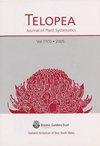Resolution of a 35-year taxonomic dilemma: Eucalyptus sp. Howes Swamp Creek (Myrtaceae) from eastern Wollemi National Park, New South Wales
IF 0.5
4区 生物学
Q4 PLANT SCIENCES
引用次数: 0
Abstract
The identity of a population of eucalypts from Howes Swamp Creek in the eastern part of Wollemi National Park in New South Wales has remained unresolved for over 35 years. Despite several workers inspecting both the site and the trees growing there over this period, little consensus has been achieved on its taxonomic status. Various suggestions have been made that the entity was a new species with affinities to Eucalyptus dalrympleana, E. viminalis or E. bridgesiana, and at one time the unpublished manuscript name E. ‘wollemiensis’ was used. Because of the perceived small population size and threats posed by wildfire and other factors, the entity phrase name E. sp. Howes Swamp Creek (M.Doherty 26) was listed as an endangered taxon in both Commonwealth and State threatened species legislation. Our investigations over the last few years, involving field, seedling, and herbarium studies, have determined the original reference specimen designated for the phrase name is E. bridgesiana, and that the population from which the specimen was gathered comprises a hybrid swarm of E. bridgesiana × E. viminalis. Both parent species are present at the site, although the former species is seemingly very rare there. We recommend that E. sp. Howes Swamp Creek be removed from threatened species legislation, and that the names E. sp. Howes Swamp Creek (M.Doherty 26) and E. ‘wollemiensis’ ms be considered nomenclatural synonyms of E. bridgesiana.一个长达35年的分类困境的解决:来自新南威尔士州沃勒米国家公园东部的桉树sp. Howes Swamp Creek(金桃科)
来自新南威尔士州沃勒米国家公园东部豪斯沼泽溪的桉树种群的身份在过去35年里一直没有得到解决。尽管有几名工作人员在这段时间里检查了遗址和生长在那里的树木,但对其分类地位几乎没有达成共识。人们提出了各种各样的建议,认为该实体是一个与dalrympleana, E. viminalis或E. bridgesiana有亲缘关系的新种,并且一度使用了未发表的手稿名称E. ' wollemiensis '。由于种群规模较小,受到野火和其他因素的威胁,实体短语E. sp. Howes Swamp Creek (M.Doherty 26)在联邦和州的濒危物种立法中被列为濒危分类群。在过去的几年里,我们通过田间、苗木和植物标本室的研究,确定了最初的参考标本是E. bridgesiana,而收集标本的种群是E. bridgesiana和E. viminalis的杂交群体。这两个亲本物种都存在于该地点,尽管前者在那里似乎非常罕见。我们建议将E. sp. Howes Swamp Creek从濒危物种立法中删除,并将E. sp. Howes Swamp Creek (M.Doherty 26)和E. ' wollemiensis ' ms作为E. bridgesiana的命名同义词。
本文章由计算机程序翻译,如有差异,请以英文原文为准。
求助全文
约1分钟内获得全文
求助全文
来源期刊

Telopea
PLANT SCIENCES-
CiteScore
1.30
自引率
42.90%
发文量
0
期刊介绍:
Manuscripts submitted for publication in TELOPEA are published online, after peer review and acceptance by the TELOPEA Editorial Committee and when final editorial formatting has been completed. The journal specialises in plant systematics and phylogeny. The geographic scope of the journal encompasses Australia, Malesia, Melanesia, Micronesia, and Polynesia. The suitability of a work for the journal depends on the topic and the region of origin, generally the narrower the focus of the manuscript the closer to New South Wales must be its geographic focus.
As a general guide, we will consider:
1) revisionary treatments and other substantial bodies of work from any of the regions mentioned above.
2) new species from any Australian state.
3) new country records for Australia from any state.
4) new state records from New South Wales only.
However, we aim to support botanical research across the broader Australasian and Pacific region, and will consider submissions on their merit.
Generally we will not consider extraterritorial new country records, or single lectotypification papers unless they pertain to New South Wales taxa, or have significant bearing on the Australian flora.
 求助内容:
求助内容: 应助结果提醒方式:
应助结果提醒方式:


